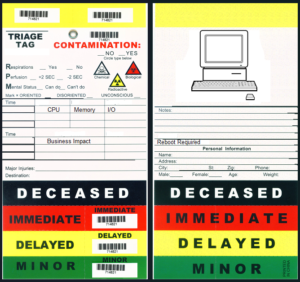Everyone deals with incidents in their own way. At a recent networking event I was speaking with a manager whose main responsibility was to manage the incident process from escalation to resolution. During the conversation he explained that they managed it much like a medical triage. Since I must have had a somewhat confused look on my face he outlined that in a past career he worked in a medical center and that this triage seemed similar since his organization was dealing with a multitude of incidents every day (I will get back to that). He said, “You probably already manage your incidents in a much similar way, but let me break it down for you in this way.”
Like an emergency room, escalations will come into the service desk and we need to identify which one of the incidents needs to be managed first.
We need to assess which incident has the most immediate need for restoration based on severity and impact. In a medical sense this might be represented by a red tag. The red tag symbolizes those who cannot survive without immediate treatment but have a chance of survival. In this organization they treat critical applications as priority 1 incidents and are managed by all available resources.
Yellow Tag
After this assessment the triage identifies what incidents are not immediate but will need to be addressed once the resources are no longer working on the priority 1 incident. Much like a medical yellow tag these patients are not in immediate danger of death but do require attention.
Green Tag
Lastly, he explained that there were also escalations which were low on the priority scale. These ‘walking wounded’ or green tags would represent issues that would get looked at after all other issues were addressed or might have had a workaround that would get them by.
I asked what about the ones that couldn’t be saved, the black tag….. he didn’t find that amusing. “We don’t have those.”
Not yet, I thought.
The first thought that I had as he described this method of triage was whether this was improving service delivery long term or not. The issues that are less impactful may in reality be slowly bleeding the organization to death, to follow the medical theme. An initial review of the health of the organization may give us a better picture of what requires improvement to build a long term strategy. This way we do not need to worry about the triage as much as the resolution of the issue at hand

